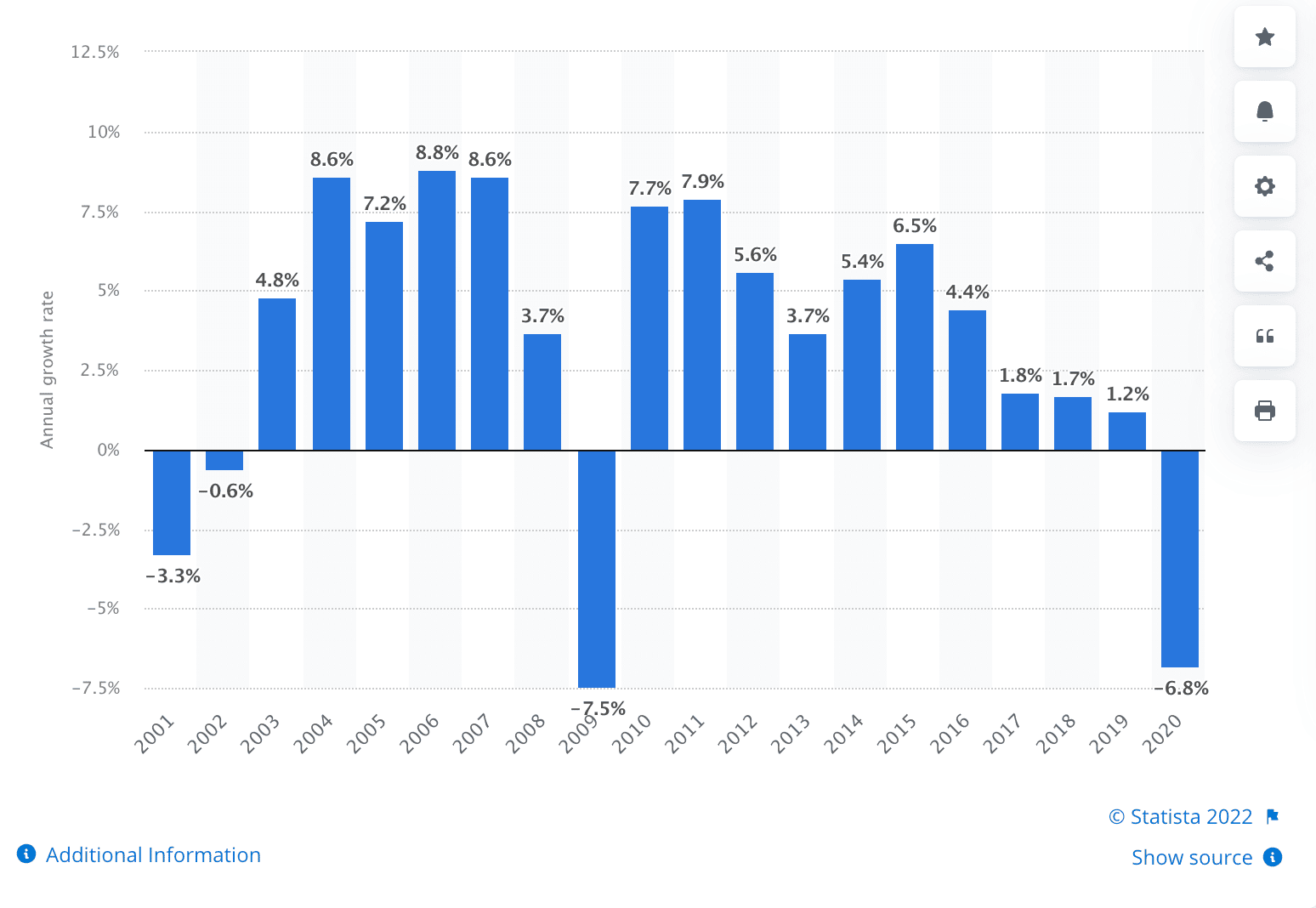Have you seen the trend of agency clients going the route of in house marketing? Let’s look at the numbers and what you can do about them.
In 2021, 41% of brands decided to sack their digital marketing agency and take their digital marketing activities in house instead. As you can see by the downward trend of agency revenue over the last 20 years, that statistic is only going to increase:
Change in Agency Revenue in the United States From 2001 to 2020
I’m guessing you already knew this, though.
But do you know why it’s happening? More importantly, do you know what you can do about it?
In House Marketing: Why Are Brands Taking Their Marketing In House?
Why would a brand choose to throw money at an inexperienced, in house marketing team rather than invest money in a team of marketing agency experts?
In house marketing challenge: You lack technical expertise
65% of businesses say that agencies don’t have the technical expertise that organizations need.
In house marketing challenge: You can’t utilize data as well anymore
50% of businesses believe they have more control over their first-party data and can utilize it better than an agency can.
In house marketing challenge: You don’t look at the whole picture
Incorporating other departments (like Sales, Product, and Customer Success) into the wider marketing strategy is crucial for a connected customer experience. But working with teams outside of Marketing falls out of the scope of many agencies.
In house marketing challenge: You’re not agile enough
61% of businesses say that agencies aren’t moving or evolving quickly enough to meet their needs.
In house marketing challenge: You can’t prove the ROI
Gone are the days when an agency could prove its value by only measuring the success of a few commoditized pieces. Now, an agency’s value lies in its ability to think strategically, to understand its clients’ audiences, to utilize social media data, to create the right messaging, and to help clients gain an outside perspective. That value can be incredibly difficult to measure.
/div>
In house marketing challenge: You don’t have strategic relationships with key third-parties
More than 50% of businesses hired an agency to optimize relationships with key tech platforms like Facebook and Google. A third of agencies don’t believe they have a strong relationship with any major tech giant.
In house marketing challenge: You can’t capture the essence of their soul
Agencies don’t live and breathe the brand, its values, or its culture, so they can’t understand how buyers think, like the brand itself can.
So, I think it’s clear: Traditional agencies have no place in today’s modern marketing world.
How Can You Maintain a Healthy Client Base?
“It is not the strongest of the species that survives, nor the most intelligent that survives. It is the one that is the most adaptable to change.” (Darwin)
The traditional agency model isn’t broken. It’s just different.
In fact, global media agencies Magna Global and GroupM predict a 10% growth for agencies willing to adapt to the changing digital marketing landscape.
Aside from the usual “develop into AI,” “offer training,” and “utilize first-party cookie data” solutions, here are a few other ideas to weather the digital marketing storm.
Partner-up to pair creative skills with data-tech expertise
According to Forrester’s predictions, intelligence fueled creativity is the future. At least for the moment. Partner up with a data-tech genius to build multidimensional, connected customer experiences.
Look at iProspects merger with Vizeum or PMG’s hiring of The Richards Group creative team. That type of partnership will appeal to CMOs because it will allow them to create innovative but practical, data-driven solutions and experiences for their customers and to send emotional but functional marketing messages that capture new audiences.
Offer consultancy services instead of generic, tangible marketing services
There will always be a need for digital marketing consultants. But you’re competing against some big players like McKinsey and BCG.
Develop a framework for delivering high-quality marketing consultancy services, within a specific industry, at a cheaper rate than the pure-play strategy consultants.
Think small and develop your reputation in highly niche areas
Learn to think like a small agency that has fewer clients, thrives on individual assignments, and must fight to prove its value every day. Perform select tasks that even the most advanced in-house teams cannot do. Like econometric modeling, for example. Meticulously gather, monitor, and report on the performance data for those tasks to demonstrate the ROI.
Then, with the ownership of data and branding kept in-house, you can prove that your agency can complement your client’s in house marketing team with specialist knowledge and niche skill sets.
White-label proven tech solutions, resell them to clients, and offer management and support packages
White labeling an already established tool or software is not a new tactic. But doing so has become increasingly effective because tech stacks are so convoluted. White label and resell a reliable, one-stop-shop tool or software that services all your client’s needs while streamlining their existing Martech stack. You’ll become indispensable if you sell support, management, and training packages, on top of the license fees.
Provide agency staff on a secondment basis and offer continuous support packages
Clients still want (need) your support. But 78% of businesses will only hire an agency that will work, flexibly, with their in house marketing team. So, offer your agency staff to your clients on a secondment basis. Even if you do so just to get the department up and running, your clients will benefit from the expertise, and you will benefit from offering ongoing support or further secondment packages.
5 Key Takeaways to Help Maintain a Healthy Client Base
- Accept that the agency-client dynamic has changed. You’re no longer needed for generalized marketing and reporting tasks. You’re needed for innovative solutions, ongoing support and advice, and specialist knowledge and skill-sets.
- Develop new, innovative solutions to challenges surrounding things like creative e-commerce, intent monitoring, ROI reporting, and connected customer experiences by partnering with tech experts and pairing tech with creative.
- Streamline tech stacks by white-labeling and reselling established one-stop-shop tools and offering ongoing support, management, and training packages.
- Develop a reputation within a niche industry and offer specialist consultancy packages at a lower cost than the big-global marketing consultancy services.
- Allow your clients to hire your staff temporarily and support them in their journey to becoming in house marketing experts.
How Agorapulse Helps Agencies Tackle the Challenges Around Social ROI Reporting
One of the major challenges that agencies face is integrating into their clients’ owned data and providing innovation around how that data can be leveraged. Taking that integrated data-led approach can allow for tracking customer behavior in more granular ways, which adds value for the client and proves the social media ROI for the services that the agency provides.
This is especially true when trying to prove the value of social media activities, as you’ll see when you download our Social Media ROI Impact Report. The report draws from three research endeavors and covers insights from hundreds of social media management and marketing executives and professionals.
Agorapulse has developed a social ROI reporting feature that allows you to easily track the performance of all your social media activity and set up regular reports that you can quickly white label and present to your clients.
Try it for free now, or book a demo.






![Feature image of Game-Changing Insights for Agencies in 2024 [Free Ebook] Feature image of Game-Changing Insights for Agencies in 2024 [Free Ebook]](https://static1.agorapulse.com/blog/wp-content/uploads/sites/2/2023/12/Have-Agency-Insights-for-2024-Blogpost-Header-1200x508.jpg)